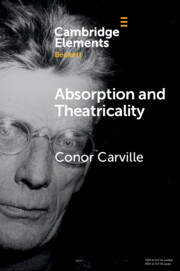Element contents
Absorption and Theatricality
Published online by Cambridge University Press: 17 February 2022
Summary
Keywords
- Type
- Element
- Information
- Series: Elements in Beckett StudiesOnline ISBN: 9781009000369Publisher: Cambridge University PressPrint publication: 17 March 2022
References
- 8
- Cited by

